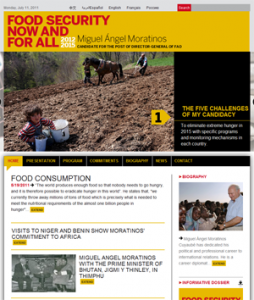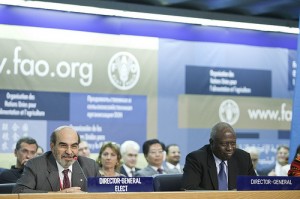
June was a busy month for multilateral elections.
Within seven days of each other, the following individuals were elected as the head of a major multilateral organization:
- UN Secretary General Ban Ki-Moon was re-elected to a second five-year term (June 21),
- French finance minister Christine Lagarde was chosen as the new Managing Director of the International Monetary Fund (June 28),
- Nassir Abdulaziz al-Nasser was selected as President of the UN General Assembly’s 67th session (June 22), and
- Jose Graziano da Silva was elected as the new Director-General of the UN Food and Agricultural Organization (June 26).
This last one, however, could not have been more different from the others.
The senior executive for the Food and Agricultural Organization is chosen by a remarkably open and merit-based process in comparison to his counterpart at the UN, the IMF or several other IGOs.
The Nomination Process
In December 2009, a “circular state letter” was sent to FAO member states reminding them that incumbent Director-General Jacques Diouf would complete a third six-year term two years later in December 2011. Members were invited to nominate candidates for the post, with the nomination period open from February 2010 through the following January.
As anyone who has been closely observing recent elections will be aware, a 12-month nomination phase is… well, extraordinary.
A lengthy nomination phase, with an announced deadline, immediately dispels perhaps the most impractical barrier to a genuine merit-based selection. The 3-week IMF nomination period did more to divide and confuse emerging economies than contribute to an effective selection process. The re-election of the UN Secretary-General election was rushed through in 15 days with no consideration of even inviting other candidates. In contrast, the FAO process allowed member governments to engage in a deliberative search for qualified nominees and to build broad support for their candidate among other governments.
Campaigning for the post
A number of civil society groups complained that Christine Lagarde has an unfair advantage with several Europeans circling the wagons in favor her candidacy before the close of nominations. Having governments refrain from pre-emptive endorsements would be ideal or expressing regional preferences and priorities, but it is not realistic. It would have required imposing some form of supranational “gag order.”
Of the six official candidates for the FAO post, Brazil’s José Graziano da Silva (Brazil) was the early favorite, securing endorsements from Mercosur, the Community of Portuguese speaking nations and other governments soon after his nomination in November 2010. Indonesia’s Indroyono Soesilo secured around 20 endorsements from Asian member states. Such pre-emptive endorsements reflected would also play a role.
A source from FAO told about its internal task, “The tradition is for the agency to go to a developing country and Brazil is not going to miss the chance to take advantage of this”. “Especially if Europe is going to take over the International Monetary Fund”.

The race got more exciting with Spain’s nomination in January 2011 of Miguel Ángel Moratinos Cuyaubé. This presented the possibility that the Latin American vote might be split and one of the remaining nominees emerging as a a compromise candidate. The suddenly competitive slate encouraged candidates to seek broad geographic support to bolster their candidacies.
The election campaign has forced the candidates to travel relentlessly in order to garner worldwide support. Mr Moratinos, for instance, has visited 90 countries since the start of the year.
da Silva, Moratinos and Indroyono also launched online campaign websites and social media profiles which touted their experience in addressing hunger and poverty concerns, and their intended approaches to improved global food security and FAO reform.
It was turning out to be an exciting race.
The Selection
In addition to an extended nomination phase, transparent multilateral elections call for information on candidates to be equally and publicly accessible to all stakeholders and for any consensus to be the result of an open and fair competition among candidates.
During the opening of the Conference — the FAO governing body — each candidate was invited to address the members of the Conference. Once again, the contrast between the UN, the IMF and the FAO were stark. At the UN, Secretary General Ban Ki-Moon met with representatives of each of the UN’s regional groups of states, in private. The IMF interviewed Christine Lagare and Agustin Carstens, in private. Candidates for the FAO top post however, addressed the Conference as a whole and their statements were recorded and made public on the FAO website prior to the election.
Voting occured by secret ballot with each FAO member casting one vote. When the first round was complete, the process called for the candidate with the lowest support to be eliminated from further consideration. This was a consensus-facilitating process used to narrow down the field in successive rounds to those candidates with the broadest support.
In the FAO election, however, da Silva and Moratinos received such overwhelming support that the remaining four candidates all voluntarily withdrew after the first round.

After a second round, da Silva squeaked out a victory, 92 to 88, over Moratinos – a margin of victory of less than 2%.
The Take-Away
Unlike al-Nasser, Lagarde or Ban, da Silva can claim to have won a genuinely competitive election open to the full membership of the world community, subject to deliberative nomination processes, deadlines, public interviews and an actual vote.
Congratulations, Director-General-elect da Silva. You’ve earned it.


3 thoughts on “Elections done right: The FAO”